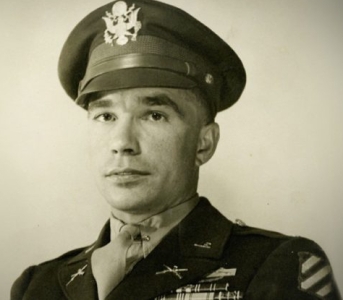
Garlin M. Conner was born on June 2, 1919, and raised in rural Clinton County, Kentucky. With the nearest high school almost 15 miles away, Conner’s formal education ended in eighth grade. He spent his teenage years working on his family’s farm and served in the Civilian Conservation Corps when he enlisted in the Army, March 1, 1941, at Fort Lewis, Washington.
Following basic training, Conner was assigned to the 3rd Battalion, 7th Infantry, 3rd Infantry Division. After several months of training, Conner and the 3rd Infantry Division deployed, Oct. 23, 1942. During Conner’s service, he fought for 28 months on the front lines in 10 campaigns, participated in four amphibious assault landings, was wounded seven times and earned a battlefield commission.
On the morning of Jan. 24, 1945, 1st Lt. Garlin M. Conner was serving as an intelligence staff officer with the 3rd Battalion, 7th Infantry, 3rd Infantry Division, near the town of Houssen, France, when German formations converged on 3rd Battalion’s position.
With his battalion at risk of being overrun, Conner volunteered to run straight into the heart of the enemy assault in order to get to a position from which he could direct friendly artillery on the advancing enemy forces.
With complete disregard for his own safety, Conner maneuvered 400 yards through enemy artillery fire that destroyed trees in his path and rained shrapnel all around him, while unrolling telephone wire needed to communicate with the battalion command post. Upon reaching the battalion’s front line, he continued to move forward under the withering enemy assault to a position 30 yards in front of the defending U.S. forces. He plunged into a shallow ditch that provided little protection from the advancing enemy’s heavy machine gun and small-arms fire.
With rounds impacting all around him, Conner calmly directed multiple fire missions on to the force of 600 German infantry troops, six Mark VI tanks and tank destroyers, adjusting round after round of artillery from his prone position until the enemy was forced to halt their advance.
For three hours, he remained in this prone position, enduring the repeated onslaught of German infantry which, at one point, advanced to within five yards of his position. When the Germans mounted an all-out attack to overrun the American lines and his location, Conner ordered his artillery to concentrate on his own position, resolved to die if necessary to halt the enemy.
Ignoring the friendly artillery shells blanketing his position and exploding within mere feet, Conner continued to direct artillery fire on the enemy assault swarming around him until the German attack was finally shattered and broken. By his incredible heroism and disregard for his own life, Conner stopped the enemy advance. The artillery he expertly directed while under constant enemy fire killed approximately 50 German soldiers and wounded at least 100 more, thus preventing heavy casualties in his battalion.
After spending over two years in nearly continuous combat, Conner was honorably discharged from the Army, June 22, 1945. Conner returned home to Clinton County after his discharge to a parade in his honor, where he met Pauline Lyda Wells. After a one-week courtship, they were married.
Conner ran a 36 acre farm in Clinton County, Kentucky, where he and Pauline raised their son, Paul. For several years, he served as president of the local Kentucky Farm Bureau, and he and Pauline volunteered their time to help disabled veterans receive their pension benefits. Conner died in 1998 at the age of 79 after battling kidney failure and diabetes.
We honor you, Garlin Conner.
